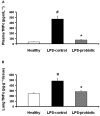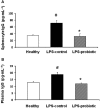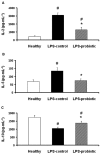A probiotic strain of Escherichia coli, Nissle 1917, given orally exerts local and systemic anti-inflammatory effects in lipopolysaccharide-induced sepsis in mice
- PMID: 19486007
- PMCID: PMC2737661
- DOI: 10.1111/j.1476-5381.2009.00270.x
A probiotic strain of Escherichia coli, Nissle 1917, given orally exerts local and systemic anti-inflammatory effects in lipopolysaccharide-induced sepsis in mice
Abstract
Background and purpose: Escherichia coli Nissle 1917 is a probiotic strain used in the treatment of intestinal immune diseases, including ulcerative colitis. The aim of the present study was to test if this probiotic bacterium can also show systemic immunomodulatory properties after oral administration.
Experimental approach: The probiotic strain was administered to rats or mice for 2 weeks before its assay in two experimental models of altered immune response, the trinitrobenzenesulphonic acid (TNBS) model of rat colitis, localized in the colon, and the lipopolysaccharide (LPS) model of systemic septic shock in mice. Inflammatory status was evaluated both macroscopically and biochemically after 1 week in the TNBS model or after 24 h in the LPS shock model. In addition, splenocytes were obtained from mice and stimulated, ex vivo, with concanavalin A or LPS to activate T or B cells, respectively, and cytokine production (IL-2, IL-5 and IL-10) by T cells and IgG secretion by B cells measured.
Key results: E. coli Nissle 1917 was anti-inflammatory in both models of altered immune response. This included a reduction in the pro-inflammatory cytokine tumour necrosis factor-alpha both in the intestine from colitic rats, and in plasma and lungs in mice treated with LPS. The systemic beneficial effect was associated with inhibited production of the T cell cytokines and by down-regulation of IgG release from splenocyte-derived B cells.
Conclusions and implications: The anti-inflammatory effects of E. coli Nissle 1917 given orally were not restricted to the gastrointestinal tract.
Figures





References
-
- Altenhoefer A, Oswald S, Sonnenborn U, Enders C, Schulze J, Hacker J, et al. The probiotic Escherichia coli strain Nissle 1917 interferes with invasion of human intestinal epithelial cells by different enteroinvasive bacterial pathogens. FEMS Immunol Med Microbiol. 2004;40:223–229. - PubMed
-
- Anderson ME. Determination of glutathione and glutathione disulfide in biological samples. Methods Enzymol. 1985;113:548–555. - PubMed
-
- Annane D, Bellissant E, Cavaillon JM. Septic shock. Lancet. 2005;365:63–78. - PubMed
-
- Arad G, Hillman D, Levy R, Kaempfer R. Broad-spectrum immunity against superantigens is elicited in mice protected from lethal shock by a superantigen antagonist peptide. Immunol Lett. 2004;91:141–145. - PubMed
-
- Ayala A, Lehman DL, Herdon CD, Chaudry IH. Mechanism of enhanced susceptibility to sepsis following hemorrhage. Interleukin-10 suppression of T-cell response is mediated by eicosanoid-induced interleukin-4 release. Arch Surg. 1994a;129:1172–1178. - PubMed
Publication types
MeSH terms
Substances
LinkOut - more resources
Full Text Sources
Other Literature Sources

